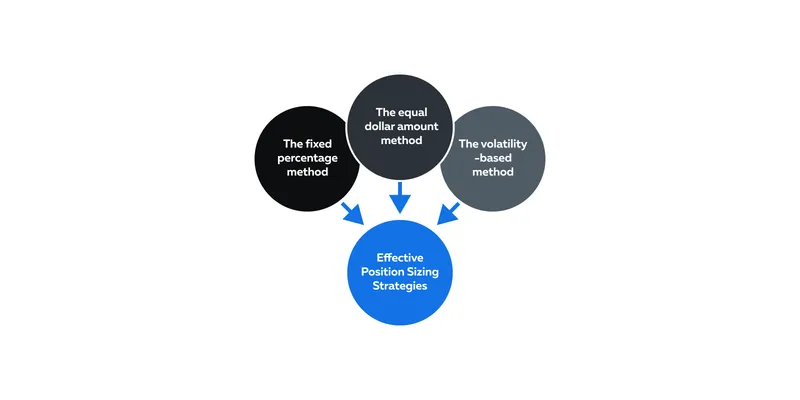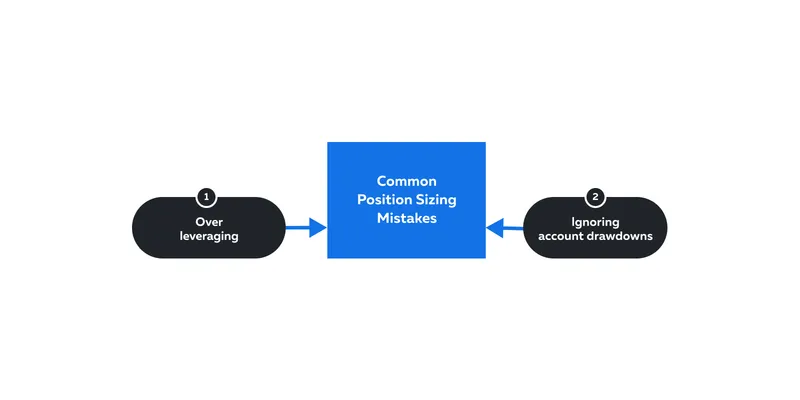Ready to see the market clearly?
Sign up now and make smarter trades today
Education
December 25, 2024
SHARE
Position Sizing for Success: How to Manage Risk Effectively
Losses in financial markets are a common occurrence. Many traders solely
chase profits without adequate trading knowledge or an understanding of
essential risk management strategies.
Position sizing is a strategic tool that doesn’t promise profits but acts as
a powerful defense, preventing financial disasters. This article explores
how this risk management tool offers protection and resilience in the
dynamic landscape of trading. So, let’s get started.
The Mechanics of Position Sizing
Fundamental to a balanced and controlled trading approach is a clear
understanding of your risk tolerance. It helps in:
-
Guiding the overall risk management strategies
-
Fostering more disciplined and sustainable trading practices
Let’s commence by defining the concept and gradually exploring the mechanics
of position sizing.
What is Position Sizing?
Position sizing is a
risk management technique
that involves determining the amount of capital to invest in a particular
trade. This quantum is largely based on:
-
A trader’s overall trading capital and
-
The potential risk or loss in that trade.
The primary objective of position sizing is to control the amount of
exposure to the market. It considers the proportion of one’s available
capital that should be allocated to a single trade. For instance, a trader
with $10,000 in capital might decide to risk only 2% ($200) on any given
trade.
How Does Position Sizing Mitigate Risk?
Position sizing ensures that a trader doesn’t risk too much, especially in
trades that don’t go as planned. It helps in:
-
Preventing the risk of substantial losses on any single trade.
-
Protecting the trading capital, allowing traders to survive in the
market even during a series of losing trades.
To understand its importance even further, let’s study a hypothetical
example.
The Scenario
-
There are two traders:
-
Trader A understands and applies position sizing
-
Trader B is ignorant and doesn’t apply position sizing
-
-
They have a $10,000 trading account.
-
Trader A only risks 2% of their capital ($200) in each trade,
whereas Trader B risks the entire capital.
The Unexpected Market
-
A sudden unexpected market swing negatively impacts both traders’
trades. -
This event resulted in a 20% loss on the trades.
The Outcome
-
Trader A, using proper position sizing, only loses 2% of their
trading capital, which amounts to $200. -
Trader B, without position sizing, loses 20% of its capital,
resulting in a $2,000 loss.
The Summary
Trader A, through the judicious use of position sizing, effectively manages
risk and safeguards their capital in the face of an adverse market movement.
In contrast, Trader B, due to overexposure and neglect of position sizing,
sustains a significant loss. This scenario underscores the critical role of
position sizing in risk management.
The Mathematics Behind Position Sizing
Determining the appropriate position size is a critical element in risk
management for traders. This process can be distilled into three fundamental
steps:
-
Understanding the trader’s risk tolerance
-
Defining the percentage of their account they’re willing to risk per
trade -
Setting stop-loss levels
Let’s simplify the math with a hypothetical example.
|
|||
|
Factors |
Formula |
Calculation |
Amount |
|
Trader’s Risk Per Trade |
Account Size × Risk Percentage |
$10,000 x 2% |
$200 |
|
Dollar Risk per Share |
Entry Price – Stop Loss Price |
$50 – $45 |
$5 per share |
|
Position Size |
Risk per Trade / Dollar Risk per Share |
$200$5 |
40 shares |
Why is it Important to Understand Your Risk Tolerance?
Understanding risk tolerance is vital for traders as it shapes position
sizing. It’s crucial because:
-
By setting a maximum risk threshold per trade (e.g., 2% of the
account), traders safeguard themselves against excessive losses. -
Knowing one’s risk tolerance helps in managing emotional responses
during trading. -
Risk tolerance percentage directly affects the initial determination
of the risk per trade, shaping subsequent calculations for position
size.
Risk Management and Position Sizing
The proper position ensures that traders do not expose themselves to
excessive risk in any single trade. By determining the appropriate position
size traders can safeguard their capital.
Additionally, regularly reviewing trades helps traders assess whether
they’ve overleveraged or overestimated their positions. Overleveraging
refers to a situation in which traders disproportionately take large
positions relative to one’s account size. Such an act magnifies potential
losses and leads to significant risks.
How Important Is Journaling in Risk Management?
Journaling involves recording:
-
Trade details
-
Strategies
-
Emotions, and
-
Outcomes.
Traders who reflect on past trades through journaling can prevent recurring
mistakes and improve decision-making by:
-
Making appropriate adjustments to their trading approaches and
-
Recognizing emotional biases or responses that influence trading
decisions
Bookmap’s Blue Jacket Content Competition

Bookmap’s Blue Jacket Content Competition
is a community approach to journaling on a larger scale. Resembling a
communal journal, it encourages traders to share their insights,
experiences, and lessons from their trading journeys. The primary focus is
on improving risk management and:
-
Self-Reflection:
-
Traders share their experiences and insights, which fosters
self-reflection and a deeper understanding of their trading
habits.
-
-
Learning from Peers:
-
The communal aspect allows traders to learn from each other’s
experiences. -
They become aware of the diverse perspectives, which improve
their trading strategies.
-
Strategies for Effective Position Sizing
There are different strategies for determining position size. Each comes
with its own set of benefits and limitations. Traders choose an appropriate
strategy based on their:
-
Risk tolerance
-
Comfort with calculations
-
Market conditions, and
-
The specific trade at hand
Now, let’s understand the different methods.

The Fixed Percentage Method
Imagine every trade as a bet in a game of poker. The fixed percentage method
dictates how much of your total chips (trading capital) you’re willing to
put down in each round (trade). Just as a poker player might consistently
bet 2% of their chips in every hand, a trader using this method risks a
fixed percentage of their total capital in each trade.
What’s the Psychology Behind This Method?
This method promotes consistency and predictability. Traders find comfort in
knowing that, regardless of the trade’s outcome, they’re risking the same
proportion of their capital.
What is the Major Drawback?
During winning streaks, the account’s growth might be slower compared to
more aggressive position sizing methods. This limits trader’s capital
appreciation during favorable market conditions.
The Equal Dollar Amount Method
Not percentage, this time the dollar amount is fixed. Following the equal
dollar amount method, a trader invests the same fixed dollar amount in each
trade, regardless of the account size or perceived risk of the trade.
|
Major Benefit |
Major Drawback |
|
|
The Volatility-Based Method
If some stocks or assets are more volatile than others, shouldn’t your stake
be adjusted based on that volatility? This method could be your go-to
approach.
The volatility-based method uses tools like the Average True Range (ATR) to
measure an asset’s volatility. ATR quantifies the average range of price
movements and considers gaps and limit moves.
Let’s understand better with a hypothetical example.
-
Stock A is a high-volatility stock with an ATR of $3.
-
Stock B is a low-volatility stock with an ATR of $1.
A trader utilizing this method would use this volatility disparity to adjust
their positions. Ideally, to manage the higher potential risk per trade, a
smaller position size is allocated to Stock A.
Common Mistakes in Position Sizing and Their Solutions

Position sizing acts as a shield that prevents traders from suffering
devastating losses. However, most traders make mistakes and fail to
precisely determine what position size will work for them. Let’s study some
common mistakes.
Over-Leveraging
Leverage allows traders to control larger positions with a smaller amount of
capital. However, this strategy is not foolproof and can backfire. Let’s
understand with an example:
-
A trader is enticed by the potential for high profits and leverages
their position significantly. -
If the market moves against their trade, the losses are also
magnified. -
A small adverse price movement can lead to substantial losses or
even wipe out the trader’s account if over-leveraged.
How to Avoid Overleveraging
|
Methods |
Explanation |
|
Self-Assessment |
|
|
Setting Strict Rules |
|
|
Periodic Reviews |
|
Ignoring Account Drawdown
Drawdowns represent periods of consecutive losses or reductions in a
trader’s account equity. It’s similar to the rainy days in trading when
losses accumulate. Just as consistent rainfall leads to a decline in
spirits, drawdowns can dampen a trader’s confidence and account balance.
Let’s understand with an example.
-
Mr. A is a novice trader.
-
He recently experienced a series of losses in his trades.
-
Up until now, he has encountered a 10% drawdown i.e., his equity
account value has dropped by 10% from its peak value due to losses. -
Such subsequent losses have severely impacted the trader’s emotional
state and ability to recover losses.
How to Mitigate Drawdowns
Some proven methods are:
-
Maintain a Drawdown Limit:
-
Set a drawdown limit, a predetermined maximum acceptable loss
level. -
For instance, if a trader decides on a 15% drawdown limit, they
commit to reassessing or halting trading temporarily after
reaching this threshold.
-
-
Using a Trading Journal for Reflection:
-
Maintain a detailed trading journal.
-
Documenting trades and emotions during drawdowns helps in:
-
Identifying patterns
-
Spotting errors and
-
Recognizing emotional triggers leading to losses.
-
-
-
Taking Breaks after Significant Drawdowns:
-
After experiencing substantial drawdowns, taking a break from
trading can be beneficial. -
This break allows traders to reevaluate their approach, regain
perspective, and reduce the emotional impact of consecutive
losses. -
It also prevents impulsive decisions made under stress.
-
Conclusion
Position sizing is neither a magic formula nor a guarantee of profit.
However, it serves as a crucial defense against catastrophic losses. By
effectively managing the size of each position in relation to their overall
capital and risk tolerance, traders can protect themselves from the perils
of overexposure and volatile market conditions.
While determining position size, most traders make the mistake of
overleveraging or ignoring account drawdowns. By journaling, maintaining
trading discipline, and avoiding impulsive decisions, traders can precisely
estimate the ideal position size and limit the impact of a bad trade on
their overall capital.
Discover the winning edge for your trading: Explore the
Bookmap Insights page
for real success stories and expert strategies from our Blue Jacket Content
Competition participants.